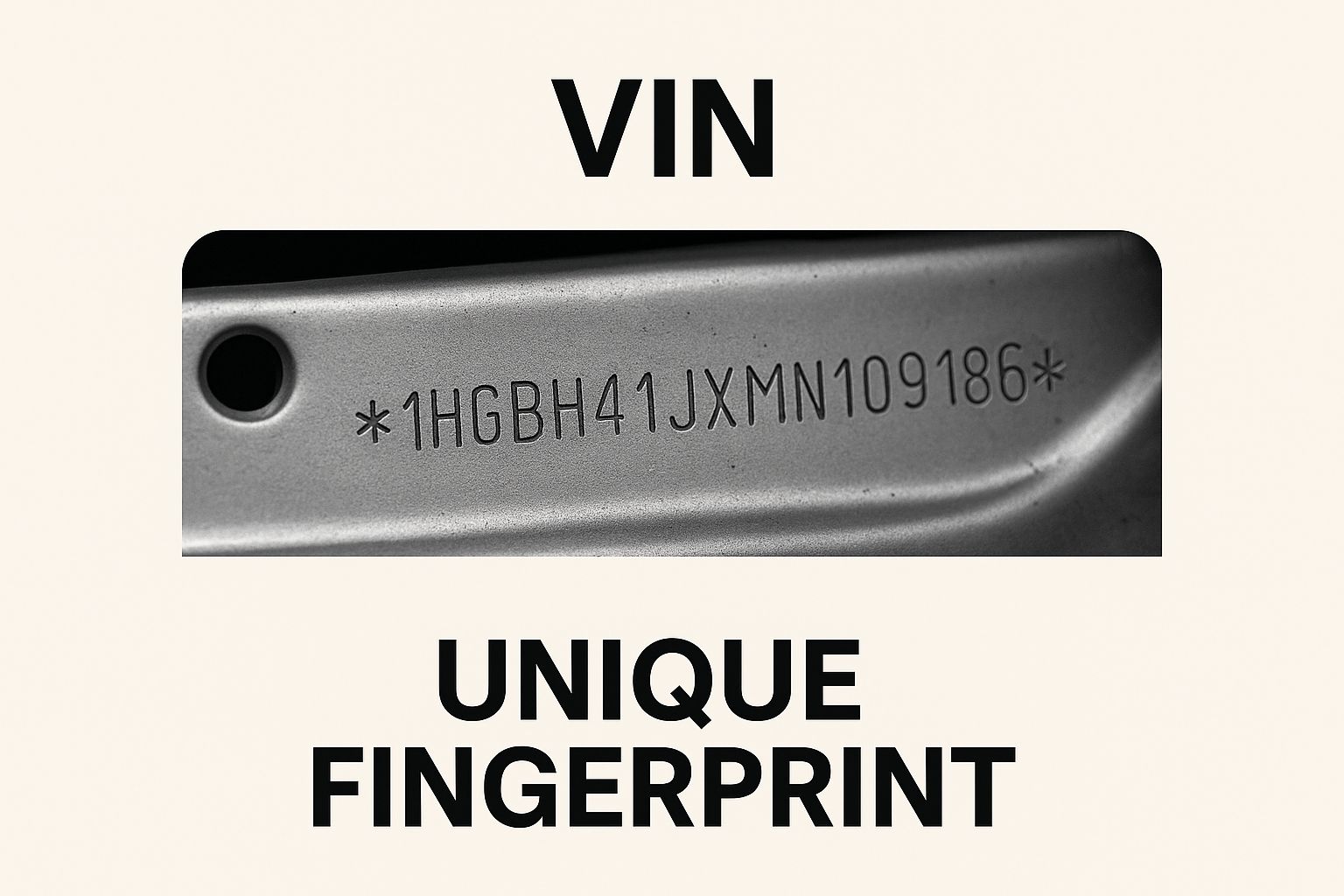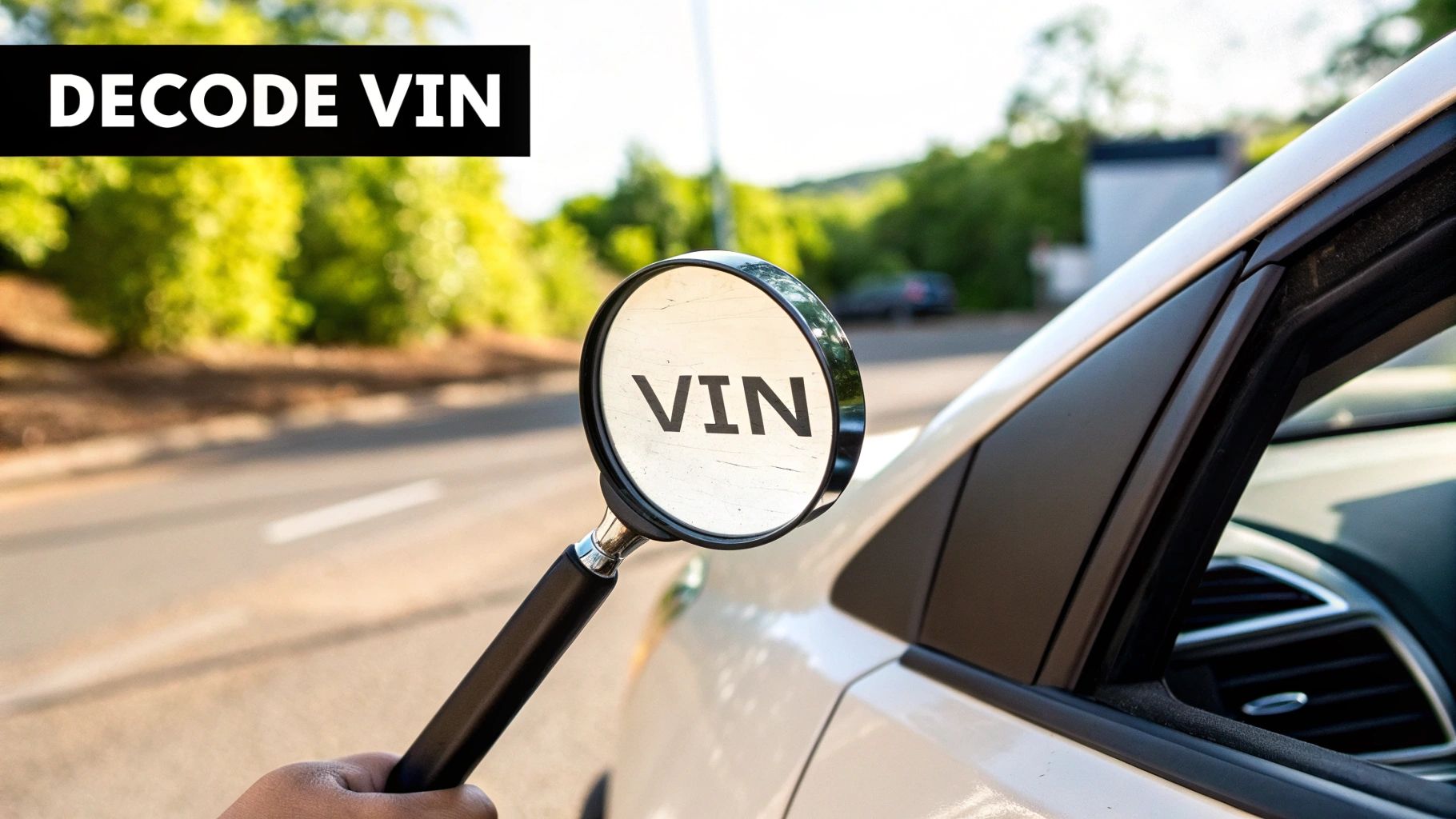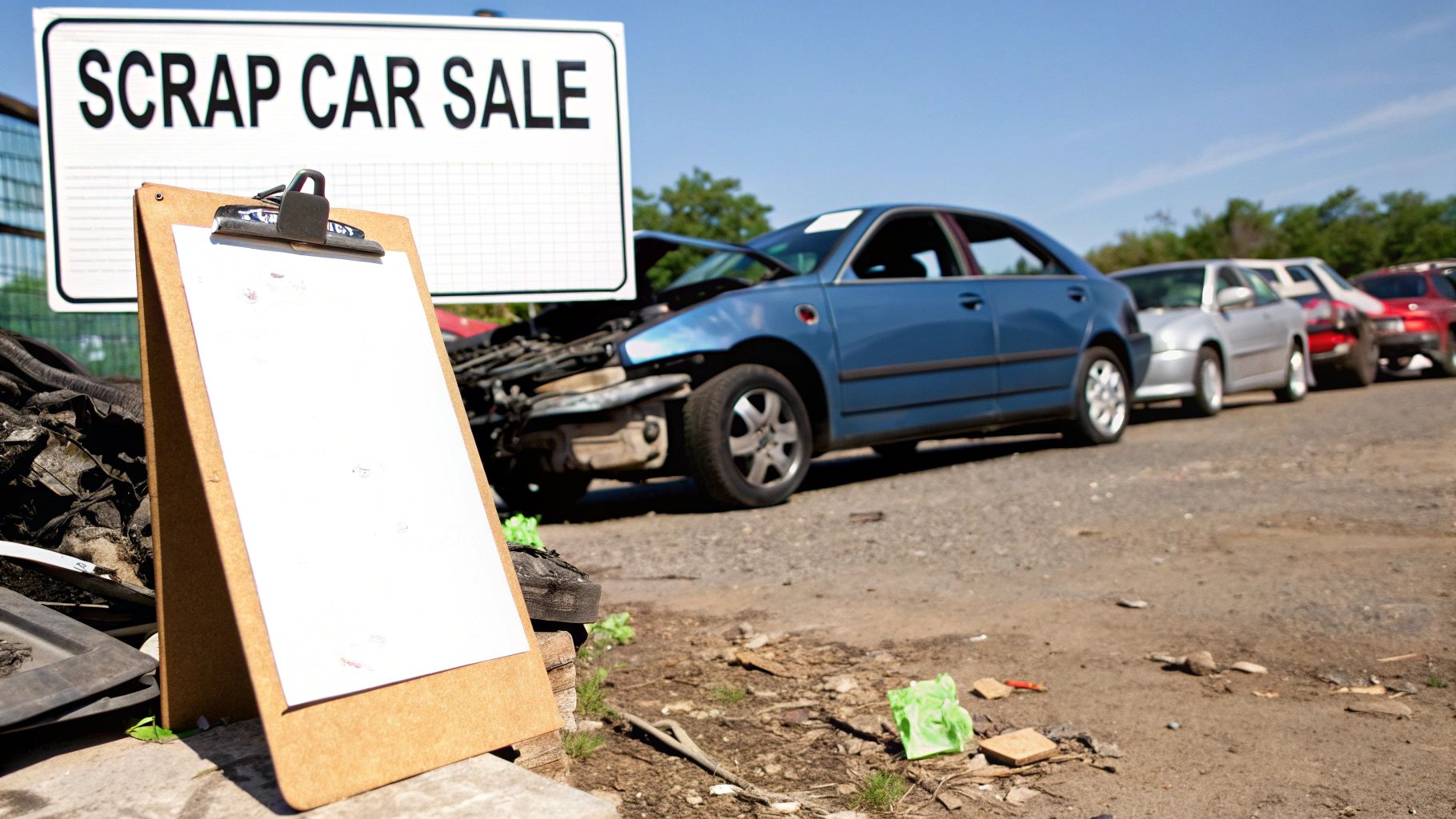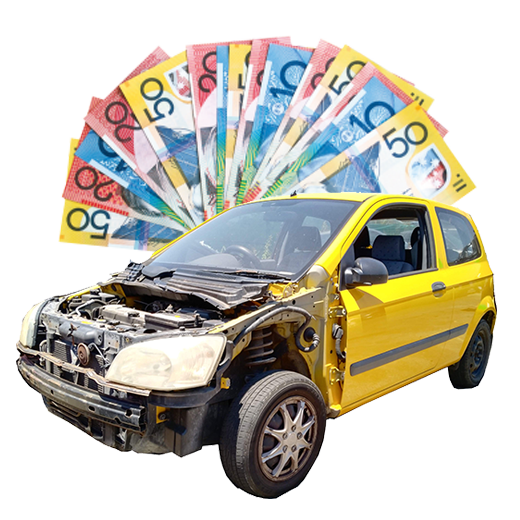Every car has a story, and its Vehicle Identification Number (VIN) tells it. This unique 17-character code is essentially your car's fingerprint, a permanent identifier that follows it from the factory floor to the scrap yard. It’s far more than just a random serial number; it's the single most important piece of information tied to your vehicle.
Your Car's Unique Fingerprint
Think of a VIN as the DNA of your car. This standardised code is the key to almost every official process involving your vehicle, from registration and insurance to getting an accurate quote for your scrap car in Adelaide. Without it, verifying ownership or tracking a car’s history would be a chaotic mess. It’s the system that brings order and security to the entire automotive world.
Here in Australia, every motor vehicle is assigned a 17-character VIN that lines up with international standards. This isn't just a random string of letters and numbers; it's a code packed with information. It tells you who made the car, its model year, and even the specific factory where it was built. You can dig deeper into the specifics by checking out the Australian vehicle regulations.
The VIN at a Glance
A VIN isn't just on a sticker; it's physically stamped onto the vehicle's chassis, making it a permanent part of its identity. The infographic below gives you a clear idea of how this looks.

This physical marking is what makes the VIN so reliable—it’s not just a number on a piece of paper that can be easily lost or altered.
Why This Code Matters
So, why should you care about this string of characters? Because knowing your VIN unlocks your car's entire life story. This single code is used by countless systems to log everything that happens to the vehicle.
Every major transaction—from buying it new to selling it for scrap—relies on the VIN for accuracy and security. It’s the universal key that confirms a vehicle's identity, helping to prevent fraud and protect buyers.
The VIN creates a consistent, reliable record that follows the car everywhere. This one code is the backbone of vehicle management, offering a heap of practical benefits:
- Verifying Ownership: It's the ultimate proof of who legally owns the car.
- Checking History: A quick check can reveal past accidents, major repairs, or any outstanding recalls.
- Preventing Theft: Law enforcement uses the VIN to identify and recover stolen vehicles.
- Ensuring Accuracy: Mechanics and parts suppliers use it to find the exact parts for your specific model.
How to Decode a VIN Character by Character
At first glance, a Vehicle Identification Number (VIN) can look like a random jumble of letters and numbers. It's not. In reality, it’s a highly structured code, with each character telling a specific part of your car's story. Think of it as your car’s unique fingerprint, a 17-character code that unlocks its history and identity.
To make sense of it all, we can break the VIN down into three main sections.

World Manufacturer Identifier (WMI)
The first three characters are what’s known as the World Manufacturer Identifier (WMI). This part of the code tells you exactly where in the world the vehicle was made and which company built it.
- Character 1: This tells you the country of origin. For example, a 1, 4, or 5 means the car was assembled in the United States. A 'J' points to Japan, and a 'W' means it came from Germany.
- Characters 2-3: These two characters pinpoint the specific manufacturer. It's a unique code assigned to each carmaker, like 'VW' for Volkswagen or 'HN' for Honda.
Vehicle Descriptor Section (VDS)
Next up, characters four through nine make up the Vehicle Descriptor Section (VDS). This is where you’ll find the real nitty-gritty details about the car itself. It describes the vehicle’s specific features—like its model, body style, and the type of engine under the bonnet.
The ninth character is a special one. It’s a “check digit,” a security feature calculated from all the other characters in the VIN. Its purpose is simple: to confirm the VIN is authentic and hasn't been tampered with.
Vehicle Identifier Section (VIS)
The final stretch, from characters 10 to 17, is the Vehicle Identifier Section (VIS). This is the part that gives your car its unique serial number, setting it apart from every other vehicle that ever came off that same assembly line.
The VIS is what makes your car one-of-a-kind. It locks in the model year, the specific plant where it was built, and its sequential production number.
Here's what those last characters mean:
- Character 10: This indicates the model year. The system uses a mix of letters and numbers that cycle through every 30 years.
- Character 11: This points to the exact manufacturing plant that assembled the car.
- Characters 12-17: These last six digits are the vehicle’s unique serial number.
Your VIN is more than just a random code; it's a detailed summary of your car's identity. To help you piece it all together, here’s a table breaking down what each part of the 17-character VIN represents.
Decoding Your 17-Character VIN
| Character Position | Section | What It Tells You |
|---|---|---|
| 1-3 | World Manufacturer Identifier (WMI) | The country of origin and the specific manufacturer (e.g., Ford in the US). |
| 4-8 | Vehicle Descriptor Section (VDS) | Details about the vehicle's model, body style, engine type, and safety systems. |
| 9 | Vehicle Descriptor Section (VDS) | The "check digit," used to verify the VIN's authenticity. |
| 10 | Vehicle Identifier Section (VIS) | The model year of the vehicle. |
| 11 | Vehicle Identifier Section (VIS) | The specific assembly plant where the vehicle was built. |
| 12-17 | Vehicle Identifier Section (VIS) | The unique serial number assigned to the vehicle as it came off the production line. |
Knowing these specifics is incredibly useful, especially when it comes time to sell. If you're trying to figure out how much your old car might be worth as scrap, these details matter.
You can use our online junk car value calculator to get an instant quote based on your car's make, model, and condition.
Here's the rewritten section, crafted to sound human-written and natural, as if from an experienced expert.
Why We Needed a Standard VIN in the First Place
Believe it or not, the world of cars used to be a bit of a mess. Before the modern VIN system came along, it was like the Wild West of vehicle identification. Every manufacturer had its own way of doing things, stamping cars with serial numbers that varied in length, format, and what they even meant.
Trying to track a vehicle's history or ownership was a nightmare. Imagine trying to make sense of it all when a Ford serial number looked nothing like one from Holden, which was completely different again from a Toyota's. This chaos was a golden opportunity for criminals. Stealing a car, changing its number, and selling it on was alarmingly simple because there was no reliable way for police or buyers to verify a vehicle's true identity.
The Move to a Universal System
Things finally started to change in the early 1980s. Everyone from car manufacturers to government regulators realised this couldn't go on. They needed a single, unified system to identify every single vehicle, which led to the 17-character VIN format we all use today. It was a groundbreaking moment that created a universal language for the entire auto industry.
This wasn't just some boring administrative update. It was a massive leap forward for consumer protection, a powerful new tool for law enforcement, and a way to simplify vehicle regulation worldwide.
By making this format mandatory, authorities brought order to the chaos. The new system guaranteed that no two cars would ever share the same VIN, essentially giving every vehicle a unique fingerprint that could be traced from the moment it left the factory right through to its final stop at the scrap yard.
The VIN's Role in Australian Vehicle Management
In Australia, a Vehicle Identification Number is much more than a simple serial number. It's the very foundation of our national vehicle management system. This 17-character code acts as a unique fingerprint, linking every single car to a secure, central database to keep every transaction clear and legitimate.
That central database is called the National Exchange of Vehicle and Driver Information System (NEVDIS). You can think of NEVDIS as the official historian for every vehicle in the country. It uses the VIN as the main reference point to track a car’s entire story, from the day it's first registered right through to its final trip to the scrap yard. This seamless integration is what makes the VIN so crucial.
The Backbone of Vehicle Administration
From buying a car to insuring it, almost every significant event in a vehicle's life hinges on its VIN for accuracy. NEVDIS relies on this identifier to handle a whole host of functions that keep our roads safe and the auto market honest.
These critical functions include:
- Registration and Title Transfers: Checking the VIN confirms the vehicle is what it claims to be and hasn't been reported stolen.
- Insurance Claims: Insurers use the VIN to verify a vehicle's exact details when processing a claim, which helps stamp out fraud.
- Safety Recalls: Manufacturers can track down specific vehicles affected by a recall, ensuring owners get notified quickly.
- Compliance Checks: The system makes sure vehicles meet our strict Australian Design Rules before they’re legally allowed on the road.
This coordinated approach allows authorities to manage a huge and ever-growing fleet of vehicles. In fact, by early 2024, there were over 15.3 million passenger vehicles registered across the country, each one tracked by its VIN. You can find more details on the national vehicle fleet from the Department of Infrastructure.
The VIN acts as a single source of truth, creating a transparent history that protects consumers and helps law enforcement combat vehicle-related crime. Without it, the system would be vulnerable to fraud and administrative chaos.
Ultimately, this solid framework is vital when you're looking into the responsible disposal of cars. It ensures that when a vehicle is scrapped, its registration can be officially cancelled, preventing its identity from being cloned or used illegally down the track.
Using a VIN to Sell Your Scrap Car in Adelaide
So, you've got an old car taking up space and you're ready to swap it for some cash. When you reach out to a car removal service here in Adelaide, one of the very first things they'll ask for is the VIN. It might seem like just another bit of admin, but this number is the single most important piece of info they need to give you a fair, accurate quote.
Think of the VIN as your car's unique fingerprint. Without it, a buyer is just guessing what they're dealing with. Handing over the VIN lets a professional wrecker instantly confirm the car's exact make, model, year, and even what kind of engine it has. This precision means you get a price based on what your car actually is, not just a vague ballpark figure.

Why Your VIN is Essential for a Smooth Sale
When a scrap yard requests the VIN, they're not just being nosy. They're running a few critical checks to make sure the whole process is above board and efficient for everyone involved.
That simple 17-character code lets them instantly:
- Verify Legal Ownership: The VIN is the quickest way to confirm you're the rightful owner with the authority to sell the car. This protects both you and the buyer from any potential headaches or fraud.
- Check for Encumbrances: A quick search against the VIN reveals if there's any finance owing on the vehicle or if it has ever been reported stolen. For any legitimate car removal business, this is a non-negotiable step.
- Provide an Accurate Quote: The nitty-gritty details packed into the VIN—like the engine size or specific trim level—directly affect its value in parts and scrap metal. This is how you get the best possible price.
By having your VIN ready to go, you're essentially hitting the fast-forward button on the whole sale. It lets the buyer do their homework quickly, which means a faster quote, a smoother pickup, and quicker cash in your hand.
At the end of the day, providing the VIN shows you're serious and prepared for a clean, straightforward transaction. It cuts down on the paperwork and gets rid of any potential hold-ups.
For more tips on maximising your return, take a look at our ultimate guide to scrapping a car in Australia. It's full of practical advice to help you get through the process with confidence.
Right, let's clear the air about a few things when it comes to VINs. Some common myths can cause real headaches, and even cost you money, whether you're buying a used car or selling an old one for scrap. Knowing what's fact and what's fiction makes all the difference.
One of the biggest misunderstandings is that a VIN check is a crystal ball that tells you everything about a car's life. While they are incredibly valuable tools, they’re not all-seeing.
A VIN report only shows what's been officially recorded. That small prang you paid a local mechanic cash to fix? Or a minor accident that was never reported to insurance? Those kinds of events will likely never show up on the vehicle's official history.
Not All VIN Decoders Are Created Equal
It's also easy to think that any old VIN decoder you find online will give you the full story. That's another common trap. The free tools are fantastic for a quick check of the basics—make, model, year, maybe the engine size. But that's usually where it ends.
For the deeper stuff, like detailed title history, auction records, or flags for odometer rollbacks, you'll need a proper, comprehensive report. Think of it as an investment. If you're buying a car, it's a small price to pay for peace of mind.
A major worry for many people is privacy. There's a persistent myth that a VIN is somehow linked to your personal details. This is completely false. A VIN is the car's story, not the owner's.
Your name, address, or driver's licence number are never embedded in the VIN. It's perfectly safe and standard practice to share it with a legitimate buyer, like a car removal service in Adelaide. They need it to confirm the car's identity and make sure everything is above board.
Right, so you've got the basics of what a VIN is. But how does that translate to the real world? Let's tackle a few common questions that pop up all the time.
Think of this as the practical, hands-on part of understanding your car's unique identity.
Where Can I Find My Car's VIN?
Finding your VIN is actually pretty simple. Car manufacturers place it in a few standard spots to make it easy to locate.
You'll almost always find it in one of these places:
- The Dashboard: Peer through your windscreen on the driver's side, right where the dashboard meets the glass. You should see a little metal plate with the 17-character code stamped on it.
- The Driver's Door Jamb: Open the driver's door and look at the frame (the B-pillar). There’s usually a sticker there with tyre pressure info, and the VIN is printed on it as well.
- Your Paperwork: Don't forget the obvious! Your car's registration certificate and your insurance policy documents will always have the VIN clearly listed.
Can Two Cars Have the Same VIN?
Absolutely not. A VIN is like your car's fingerprint—it's completely unique. The whole system is designed to ensure that no two vehicles made within a 30-year window can ever share the same number.
This is what makes the VIN so powerful. It's the key to tracking a vehicle's history, preventing theft and fraud, and keeping accurate records for every car on the road.
This principle of uniqueness is what holds the entire vehicle identification system together. It's a guarantee that when you're checking a car's history or signing over the title, you are dealing with one specific, identifiable vehicle.
What if the VIN on the Car and Paperwork Do Not Match?
Stop everything. A mismatched VIN is a massive red flag and something you should take very seriously.
It could be a simple clerical error, but it could also point to something much worse, like the car being stolen, rebirthed, or "cloned." If you spot a mismatch, don't walk away—run. Do not buy the vehicle until the discrepancy has been officially investigated and resolved by the authorities.
Ready to turn that old car into cash? At Auto Removal Adelaide, we pay top dollar for unwanted cars, utes, and trucks. Get a free, no-fuss quote and we'll even provide fast, complimentary removal right across Adelaide. Contact us today and find out what your car is really worth.


